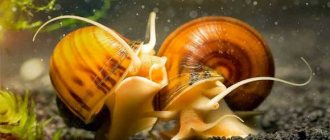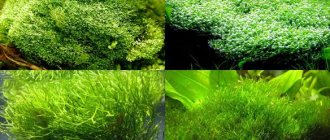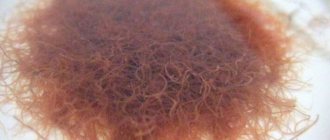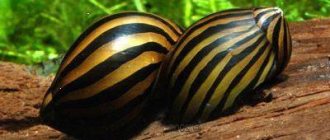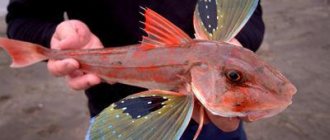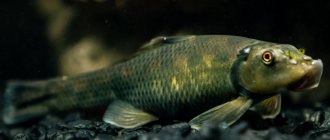Aquarium snails are not only a good decoration, but also orderlies who clean the bottom of the tank from silt and accumulated food residues. The favorites of many aquarists are Ampularia . These are unique mollusks, whose homeland is considered to be the swamps and rivers of South America. There is another name - apple snail. Thanks to their natural habitat, snails are accustomed to low water quality, which makes these mollusks absolutely unpretentious to keep. Ampularia snails are easy to feed, care for and breed. But before you introduce Ampulyaria into your aquarium , you need to learn more about their characteristics and behavior. This will be discussed in more detail in this article.
Ampularia snails in an aquarium
Habitat in nature
The historical homeland of these lungfishes is South America, from where they were brought to Germany in 1904. This is where their journey as aquarium inhabitants began.
Under natural conditions, these snails prefer fresh water bodies with low oxygen content .
But thanks to the design of its respiratory apparatus, the snail breathes both oxygen dissolved in water and air oxygen.
The ampularia spends almost (since without moisture its body dries out and it dies); the mollusk ends up on land either by accident or to lay eggs.
Other shapes and similar species
As a result of selection, snails of uncharacteristic color appeared.
| Variation | Shell color | Body color |
| Brown | Resembles natural form, brown with dark stripes | White to cream |
| Yellow Golden Mystery Snail | Yellow to light brown, golden, no stripes | White |
| Brown-blue (rare) | Brown, striped | Blue-gray to black |
| Yellow-blue | Yellow, no stripes | Bluish-gray to black |
| Blue | White | From gray-blue to blue |
| Lilac (purple, blueberry) | Purple with pinkish-brown stripes | From gray to blue |
| Pink | Pink with darker pink stripes | White |
| White (pearl, ivory snail) | White | White |
In the 1960s, the yellow form of ampularia became known. This form is gradually replacing the brown one.
Varieties:
Pomacea canaliculata (Channeled Applesnail)
Pomacea paludosa (Florida Applesnail)
Pomacea scalaris
Pomacea canaliculata began to be bred as a food product in Taiwan in the 1980s. Snails contain a lot of protein. The local population is deficient in this substance, eating mainly only rice. But this attempt failed. In addition, it turned out that the snails carry a parasite - the rat worm.
Externally, the ampularia resembles the Viviparus livebearer snail. Thus, the snail Cipangopaludina chinensis lives in China, and Cipangopaludina japonica lives in Japan. These mollusks are also called Misterysnail.
Description, benefit or harm
These mollusks belong to the gastropod class (family Ampullariidae). Among the mollusk's closest relatives there are tiny species and real giants that can grow up to 8 cm.
There are colored and yellow-brown ampularia, with a large spiral-curled shell.
Another feature of ampularia is the operculum, a small black or dark brown lid. With its help, the snail seals the mouth of the shell.
This door protects from predators and allows the mollusk to wait out an unfavorable situation in safety.
View this post on Instagram
Posted by Alexander Svid (@sviderskyy.alex) May 3, 2021 at 2:29 PDT
Do ampularia spoil plants?
It is reasonable to fill the aquarium where snails live with flora with hard leaf plates:
- Anubis;
- cryptocorynes;
- Vallisneria gigantea.
Attention! Snails are omnivorous and extremely voracious. If there is a shortage of food, they can - and will have an appetite! - eat plants, which will ruin the interior of the pond. Hard leaves will become, although weak, protection of the plantings.
How long do they live in an aquarium?
The life cycle of snails is related to temperature and water quality .
At elevated temperatures, they will be active, begin to grow quickly and reproduce, but this will shorten the life span of the mollusks.
It is optimal to keep snails at a reservoir temperature of 18 to 25 ° C; in this mode they will live for about 5 years. If the indicator is higher, the snail will last no more than one and a half years.
Can ampoules tolerate salt water?
These snails are freshwater, but they will tolerate slightly salted water .
You need to increase the salt content in the aquarium gradually: if you notice that the ampularia has closed the valve, reduce the salt concentration until the mollusk dies.
Do ampullaria carry parasites?
In natural conditions, there are several varieties of parasites that are carried by snails.
Ampularia bred in an aquarium environment simply cannot have parasites , since there is no contact with their main carriers - wild rats.
But even if the mollusk is a carrier of the parasite, a person must eat a raw snail to become infected.
Ampularia can survive without water
The snail will spend a short time without water without any special consequences, but time of more than a day on land is guaranteed death for the snail. Her delicate body quickly loses moisture, and the mollusk dies from dehydration.
Important! You should cover the aquarium with ampularia with a lid and do not leave any holes.
Can a snail survive in a pond?
As long as the water temperature is within 18...20 °C - yes. But as soon as the water gets colder, the ampularia will die.
Ampullaria hibernate
Under natural conditions during drought, yes. But in an aquarium, the ampoule has no need for suspended animation.
View this post on Instagram
Publication from Sergey (@stav_akva) April 15, 2021 at 10:33 PDT
Maintenance and care
The aquarium is selected at the rate of 10 liters per individual.
The top of the tank is covered with a glass lid: snails often crawl out. This is dangerous because after 40 hours without water the mollusk begins to dry out. If dropped or hit, the sink may be damaged.
The air cushion between the water surface and the snail glass must be at least 5 cm so that the snail can breathe atmospheric oxygen.
Soft soil is poured onto the bottom of the aquarium. Plants are planted with hard leaves, since tender greens will be quickly eaten.
Water
- Ampularia requires hard water 8–18°. If the indicator is lower, the shell loses strength due to lack of calcium. The temperature can be 18...35 °C. But such significant deviations from the norm affect life expectancy and activity.
- So, at high temperatures, metabolism accelerates, and the snail lives no more than 2 years. In cold water, the behavior changes - the ampularia is less awake and spends more time sleeping.
The aquarium must have filtration with aeration. The lighting is natural.
Nutrition
In nature, ampularia prefer plant foods. But when kept in an aquarium, they like protein products. The diet includes tubifex, bloodworms, and scraped meat. Dry food intended for fish is eaten well. They also love to eat salad leaves. Occasionally give the snails scalded semolina.
Many ampullaria sold in pet stores suffer from diseases associated with improper living conditions and unbalanced nutrition. The shell softens in captivity because the body lacks calcium. Therefore, shellfish need supplements with this mineral.
What to feed
Ampoules eat almost all types of dry food; they will not refuse live food , but then you need to provide access to it.
Snails love vegetables. To feed clams with cucumbers or zucchini, you need to prepare them - boil them a little.
You should not keep a portion in the tank for more than a day - the water may become very cloudy.
In addition, ampullaria eat up the leftover food from other inhabitants of the aquarium and will not refuse to taste ornamental plants.
Feeding
The aquarist decides whether snails are needed in the aquarium, but ampularia can become an additional assistant in cleaning the tank from decaying organic matter. Beneficial snails perform a sanitary function.
What do ampularia eat in an aquarium:
- Food leftovers;
- Dead fish and shellfish;
- Daphnia, bloodworms, tubifex;
- Plant foods - lettuce leaves, zucchini, carrots, cucumber;
- Tablet food.
Inexperienced breeders are not sure whether the snails eat the fish in the aquarium. There is no need to worry about the life of aquatic inhabitants: rumors about whether snails can eat fish in an aquarium are empty. Despite their size, ampullaria are slow and are not even able to get close to the nimble fish. And they are not predators, but scavengers, feeding on dying organic matter.
What to feed ampularia for active growth: egg whites, chicken fillet, boiled squid. Vegetables are pre-scalded. Snails love the darkened skin of bananas.
Breeding
Ampularia are not hermaphrodites, so to produce offspring you will need a male and a female . The easiest way to get both sexes is to buy 5-6 snails at once.
Once the snails reach sexual maturity, they will begin to reproduce on their own, without any stimulation.
From egg to snail - how long?
After mating, the female crawls to the surface (you can arrange a suitable place: a floating island or a large leaf) and lays a large number of pale pink eggs .
In order for the eggs to hatch, the following conditions are needed:
- it should not be immersed in water;
- air humidity should be high;
- the air temperature is not lower than 21 ° C, but preferably higher.
If these conditions are met, small, fully formed snails will appear in a few weeks.
Can snails reproduce throughout the year?
Yes. Although the intensity is noticeably lower in winter, reproduction begins immediately after reaching sexual maturity and under favorable conditions.
Ampularia has laid eggs - do you need to do anything?
Basically nothing. If the conditions are favorable, the eggs will not be lost and new mollusks will hatch.
But if you really want to, you can catch the eggs and place them in an incubator where optimal conditions are created.
Is it worth somehow setting up a place where they can lay eggs?
There is no need to create special places. It is enough to cover the container with a lid and provide space between it and the surface of the water. But if you really want to, launch a small island.
Care of masonry development of larvae
The masonry does not require special care, the main thing is that there are no heat sources nearby (for example, the masonry is located too close to a lighting lamp), where it can dry out.
In this case, the eggs will have to be carefully cut from the wall of the aquarium and placed on a floating island.
Conditions for raising young animals
The main conditions for the successful development of masonry are high humidity and warmth . If these factors are observed, the eggs will develop into small ampularia.
General information
Melanoids (Melanoides sp.) are freshwater snails from the Tiara family. These gastropods live in muddy and sandy soils of water bodies and are nocturnal. In nature, their ecological role is significant - they are detritivores, that is, they feed on decaying organic matter. They also serve as intermediate hosts for some types of parasitic worms.
Melania can often be found in freshwater aquariums, and not a single “fish farm” is immune from the appearance of these ground dwellers. Newborn snails are so small that it is almost impossible to notice them with the naked eye. Mollusks usually enter a new aquarium with plants, decorations or soil.
The attitude of aquarists towards melania is ambiguous. One group believes that they do no harm and does not see any problems from their presence in the aquarium, while the other perceives them as exceptionally evil and tries by all means to survive these uninvited guests.
Among the features of melania are fully gill breathing and viviparity. Snails do not need to periodically rise to the surface of the water to take a breath of atmospheric air; they can constantly remain in the ground. Due to viviparity, melania have incredible reproduction rates. In uncontrolled conditions, their numbers grow exponentially, to the point that sooner or later the aquarist discovers “living” soil - so many snails can be between the stones. This creates certain difficulties in the fight against melania.
Compatibility
Ampoules are completely harmless to fish, they are peaceful and calm . But fish (especially active barbs or cichlids) can offend mollusks by biting off their antennae.
Compatibility of apple turtles and red-eared turtles
Bad. Red-eared turtles are noticeably faster than snails, and the strength of their jaws is more than enough to break the shell of even a large snail.
Will Ampularia and Helena get along or not?
Predatory snails - helens - can, in principle, coexist with large ampullaria, provided there is a sufficient amount of food. But small ampularia from Helen are guaranteed to suffer .
Can ampularia eat fish?
No, she doesn't eat them. The snail will not eat live fish, but it can gnaw a corpse.
Possible difficulties
Even such picky aquarium inhabitants as ampularia can add trouble to aquarists. They may get sick or behave strangely.
The snail does not move for several days - what happened?
This is most likely due to a decrease in the water temperature in the aquarium and a decrease in the snail's activity. It is worth checking the thermometer and adjusting the mode if necessary .
The sink has a non-uniform color - what does this mean?
The appearance of spots on the shell is caused by a change in living conditions (the snail was transplanted to another aquarium, the food was changed, it starved for some time) - all these factors leave marks on the shell.
This does not pose a threat, the main thing is that the conditions in the future are favorable.
The sink is collapsing - what happens?
Unfortunately, this is possible due to the quality of the water. It's too soft or old.
There is not enough dissolved calcium in the water and, as a result, the snail’s shell is destroyed. You can solve the problem by changing the water or adding the necessary microelements.
Ampularia are inactive, often lie down and do not move, although I feed normally and the conditions are good
Most likely, there is no reason to panic. Snails by their nature are very lazy and if they are full, then they don’t have much need to move .
After some time (as they get hungry), the mollusks will again show interest in life.
If the ampularia floats on the surface, is it dead?
Not at all. Maybe she just wants to breathe . Checking the condition of a snail is very simple - catch it and hold it in the palm of your hand. If the ampoule closes the door, everything is fine with it.
Snail buried in the ground
She won't have the strength to pull off this trick completely. She can only partially bury herself in a soft substrate and hibernate for a while . It’s better not to touch it, but just observe.
Lifehacks by content
- You can plant not only hard-leaved plants in reservoirs, but also inedible plants - for example, Canadian elodea. This achieves biological balance in the aquarium.
- When purchasing shellfish, you should inspect them. You should not buy individuals with cracks or damage to the shell. The snail being inspected must be attached to the surface of the aquarium or move along the walls.
- In addition, shellfish lovers do not recommend buying specimens that are too bright. They suspect that sellers achieve a catchy color using food coloring. Some buyers complain that shortly after purchase, the ampularia quickly lose color and even die. And to avoid getting into trouble, experts advise first becoming familiar with the natural appearance of snails and looking at them in person.
How to control the number of ampularia in an aquarium
This is easy to do. The most common methods of combating overpopulation:
- Remove clutches of eggs - they are easy to spot on the walls.
- Use a net to catch the snails.
- Get predatory helen snails - natural enemies will regulate the population of mollusks.
Ampoules are wonderful, peaceful inhabitants of the aquarium. Their large size and beautiful shells can complement the image of an aquarium.
In addition, they help maintain the ecosystem of the reservoir and just look great .
